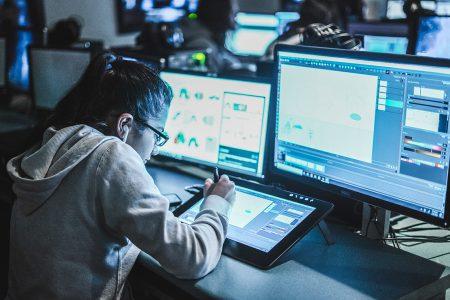By Dang Le/managing editor

In a darkened classroom, students faced glowing monitors with headphones on, listening for sound cues while controlling the characters in a video game. It may look like they’re playing, but instead they’re learning how to build the many layers of a video game in the Game, Simulation & Animation Design program.
With the progression of technology, demand in game development and new consoles out this year, South is the only campus that currently offers this program.
South assistant professor of computer science Donald Cunningham said students who join the program would graduate with an Associate of Applied Science degree, which requires 60 credit hours.
“They could come in and complete six GAME-prefix classes and get a Level 1 certificate and stop at that point if they want to,” he said. “Or, they can continue it further and add more core-based classes to it and end up with a Level 2 certificate, which is a more advanced certificate.”
Students can work on structuring storyboards, crafting character works or recording voice-overs until they can find one area they enjoy or that is in high demand so they can focus on that, Cunningham said.
The program concentrates on industry-standard applications like 3ds Max or Mudbox, which create 3D animations and designs.
Game development companies are looking for people who can work around software rather than techniques, Cunningham said.
Outside of the design software, the program also touches on two products from Toon Boom, Storyboard Pro and Harmony.
While the former helps students with drafting the ideas and crafting storylines, the latter is used to create 2D animations.
Since the program is flexible for students pursuing an AAS degree, South student Stuart Helm is completing two degrees at the same time, one of them being the Game, Simulation & Animation degree.
“I had already taken all of the core classes shared by the IT computer programming and game/sim/animation degree, so I only had to take the GAME courses,” he said. “I thought that getting both degrees would be good to have.”
Some students who just joined the program now understand the complicated effort to put a video game together.
South student Clara Howard, who is in the second year of the program, said taking the classes have given her a stronger appreciation toward developers as a whole.
South student Jasmine Pate, who has nearly finished the first half of the program, said she learned to never rush producing anything again.
“When I see people complain about how long the process is, they have to understand a lot is going into gaming like coding,” she said. “When we see unfinished games, it’s irritating because people could have spent more time and done more to it.”
Other than the design aspects, students will also work on layering the sound features from voice-overs, background score or special effects.
South computer information technology adjunct instructor Vaughn Groom takes care of that portion in his GAME 1443 class, which uses Unreal Engine to implement audio in games and simulations.
“The thing about music is that people don’t notice it a lot, but they can experience it,” Groom said.
While other courses teach students how to create objects, animations or design characters, Groom’s class focuses on combining audio with them.
“On the one hand, you want it to be realistic for the gamers ‘cause they pick up on things that are artificial sounding,” Groom said. “The other thing is, if you make it too perfect, then it takes up a lot of computer resources on small platforms like iPad.”
Although Groom’s students may generate some things on their own, most of the work uses existing levels from the textbook to set up.
In the future, Groom and the department plan to give him a second course, which allows students to be more practical and not be restricted with the given software.
“We’re gonna add some things related to omitted reality because that opens to a whole new area of sounds in games that use augmented reality or the virtual reality,” he said.


